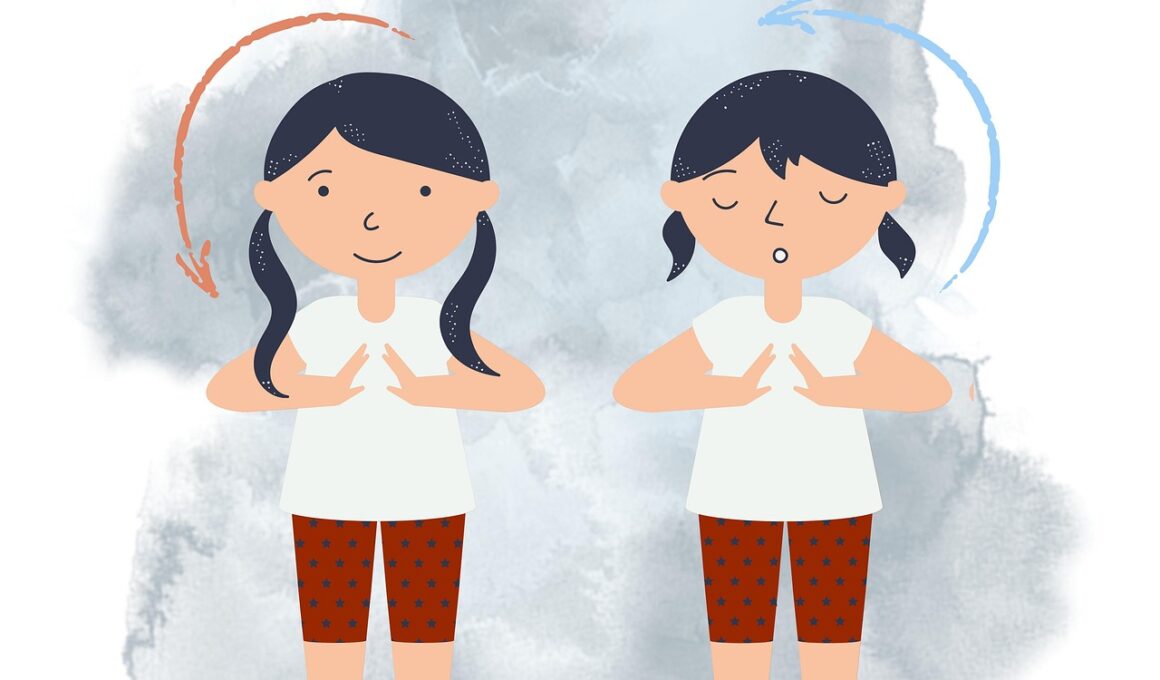Introducing Mindfulness and Yoga to Kids
In today’s fast-paced world, introducing mindfulness and yoga practices to children can help them develop healthy habits that last a lifetime. Mindfulness encourages kids to pay attention to their thoughts and feelings, helping them regulate emotions and reduce stress. Additionally, yoga promotes physical fitness, flexibility, and strength, while enhancing mental clarity. Parents and educators can play a vital role in facilitating access to these practices, ensuring that children understand their benefits. Creating a comfortable environment for yoga and mindfulness can help enhance focus and engagement. Here are some tips to integrate these practices into children’s lives: 1. Start Small: Introduce brief sessions that gradually increase. 2. Use Fun Themes: Incorporate animals or nature into the learning process. 3. Be Patient: Allow kids to learn at their own pace and enjoy the experience. By making mindfulness and yoga enjoyable, children are more likely to embrace these activities wholeheartedly. As these positive habits take root, children can experience a range of benefits, including improved concentration, better sleep, and increased resilience against challenges. Thus, early intervention in mindfulness education can inspire a healthier generation in the long run.
To further understand the connection between mindfulness, yoga, and child development, consider how these practices foster emotional intelligence. Children who engage in mindfulness exercises often become more aware of their emotions and learn how to express themselves. This heightened awareness can lead to improved communication skills, allowing them to interact harmoniously with peers. Yoga also supports this development by teaching discipline, commitment, and self-care. Through regular practice, children build resilience, which is essential in navigating life’s challenges. Schools have recognized these benefits, incorporating mindfulness and yoga programs into their curriculums. Furthermore, research has shown positive impacts, including reduced anxiety and enhanced academic performance among kids who practice mindfulness regularly. In addition, these practices promote a growth mindset, encouraging children to view challenges as opportunities for learning. Here are further advantages: 1. Improved Focus: Children are less fidgety and more capable of concentrating. 2. Social Skills: Mindfulness encourages empathy and cooperation within groups. 3. Physical Fitness: Yoga builds strength while improving flexibility and balance. Embracing mindfulness and yoga can thus create a nurturing atmosphere where kids thrive. By integrating these practices into their daily routines, they can grow into more balanced individuals.
The Importance of Routine
An essential aspect of introducing mindfulness and yoga to kids lies in creating a consistent routine. Establishing a set time each day for these practices encourages children to form a habit. For example, dedicating just ten minutes every morning or evening can lead to observable changes over time. This consistency helps reinforce the benefits, as kids learn to expect and look forward to their moments of mindfulness and reflection. When a routine is established, children can anticipate these sessions as a time to unwind and relax. Additionally, teaching them simple breathing exercises can facilitate mindfulness, allowing them to focus and diminish distractions. Breathing is a fundamental aspect of both yoga and mindfulness training. Another factor contributing to successful integration is family involvement; when parents and siblings practice yoga or mindfulness together, it strengthens bonds and creates a support system. Here’s how families can encourage mindfulness: 1. Share together: Engage in mindful activities as a group. 2. Discuss emotions: Encourage open conversations about feelings. 3. Celebrate successes: Acknowledge children’s progress and achievements in the practice. By turning mindfulness into a cherished family experience, it enriches everyone’s lives.
As children develop a deeper understanding of mindfulness and yoga, they can experience great benefits, including stress reduction and improved emotional regulation. These practices can help in teaching children how to handle impulses and work with challenging situations. By engaging in mindfulness activities, kids can learn to pause, reflect, and respond appropriately instead of reacting impulsively. Yoga complements this by offering tools for physical and mental relaxation, creating an environment that supports emotional well-being. Consequently, children become more equipped to face challenges, whether at school or home. Over time, these practices yield a calmer demeanor and enhanced capacity to engage with others compassionately. Interestingly, various studies have linked mindfulness practices to lower levels of anxiety and depression. This is crucial as many children face academic pressures that can be overwhelming. Mindful children are taught various techniques to regulate emotions, which leads to improved behavior and relationships with peers. Educators can play a fundamental role in reinforcing these lessons. Here are some effective classroom strategies: 1. Integrate mindful moments in lessons. 2. Create a calm corner for reflection. 3. Encourage journaling or drawing for expression. These strategies can ultimately foster a healthier educational environment.
Fun Activities to Engage Kids
To successfully engage children in mindfulness and yoga practices, it’s essential to incorporate fun activities that capture their interest. Creative approaches to mindfulness, such as storytelling, can help make the concepts more relatable and enjoyable. Similarly, playful yoga poses can turn what may seem daunting into an exciting adventure. For example, introducing animal-themed poses, like downward dog or cobra, can elicit laughter and enthusiasm as kids imitate their favorite creatures. Further, imaginative games involving mindful breathing can keep children excited about participating. Activities such as blowing bubbles while focusing on breathing can turn a drill into a playful session. Additional engaging strategies may include: 1. Crafting a mindfulness jar to visualize emotions. 2. Utilizing music for guided relaxation and movement sessions. 3. Hosting friendly yoga challenges that encourage collaboration. By providing stimulating activities, children are encouraged to explore mindfulness and yoga without feeling pressured. These practices can become enjoyable milestones in their daily lives. When kids associate mindfulness and yoga with positive experiences, they’ll be likely to engage with them long-term, benefiting not only their physical well-being but their emotional and mental health as well.
Incorporating technology can also enhance the practice of mindfulness and yoga among kids. Utilizing apps or online videos tailored for children can make these activities even more engaging. These resources often present yoga sessions in a fun, colorful format, capturing their attention effectively. Moreover, guided meditations specifically designed for children offer an interactive way to learn mindfulness techniques. By integrating these digital tools into daily routines, kids can access quality mindfulness and yoga practices anytime, anywhere. Furthermore, it inspires them to take ownership of their wellness journey, an essential life skill. Alongside traditional methods, technology can facilitate learning in unprecedented ways. However, it is vital to balance screen time and ensure children engage in physical activities. Parenting strategies should reflect this balance, promoting activities without overexposure to screens. Here are a few recommended apps: 1. “Calm Kids” for guided meditations. 2. “Yoga for Kids” introducing poses; 3. “Headspace” featuring tailored content for young audiences. When kids blend these tools with real-world practices, it enriches their experience, increasing retention and engagement. Ultimately, the goal is to empower children to embrace mindfulness and yoga as lifelong companions.
Conclusion: Building a Mindful Future
In conclusion, encouraging mindfulness and yoga at a young age sets the foundation for a healthier, more balanced future. As children develop their emotional resilience, they acquire skills that last into adulthood. These practices not only promote physical health but also enhance social skills, emotional intelligence, and overall well-being. By integrating mindfulness and yoga into children’s lives, they gain tools to face challenges, build empathy, and cultivate peace of mind. To foster an environment conducive to growth and exploration, parents, educators, and communities should work collaboratively to provide resources and support. Educational institutions must prioritize these elements in their curriculums, promoting mental wellness alongside academic learning. Efforts to create engaging activities and practices must remain a priority. With proper encouragement, the next generation can flourish in a world that can sometimes be chaotic and demanding. As children embrace mindfulness and yoga, they transform into compassionate, resilient individuals, ready to face their futures. The impact of these practices is profound and long-lasting, encouraging a brighter and healthier society. It is vital for ongoing discussions and practices that continue to foster healthy habits from an early age, creating a ripple effect that benefits everyone.
Ultimately, the journey of incorporating mindfulness and yoga into children’s routines is one worth embarking upon. The experiences and skills gained through these practices can serve as a cornerstone for overall health and wellness. While the path may require patience and persistence, the rewards are invaluable. Children not only learn to cope with life’s challenges, but they also discover their own inner strength and resilience. The investments made today in developing healthy habits will inspire tomorrow’s leaders and changemakers. As we continue to explore and innovate in how we approach fitness, we must keep mindfulness and yoga at the forefront. By nurturing these practices, we pave the way for a future where children thrive emotionally, mentally, and physically. The aim is to encourage future generations to appreciate the importance of self-care and well-being. When children are equipped with these tools, they are empowered to create positive change, both within themselves and their communities. As we move forward, let’s make a collective effort to instill these values and practices. Embracing mindfulness and yoga means giving children the opportunity to unlock their full potential, ensuring they lead fulfilling lives.


